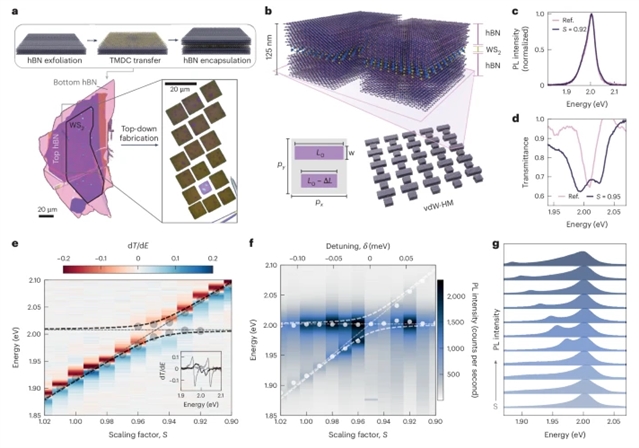
近日,德国慕尼黑路德维希马克西米利安大学Andreas Tittl团队研究了范德华异质结构超表面超薄光学腔的原子层组装。相关论文发表在2025年5月26日出版的《自然—光子学》杂志上。
光学超表面的进步彻底改变了光子学,为平面光学元件的设计和工程创造了机会。同样,分层二维材料通过垂直异质结构的确定性组装实现了物理学的突破,允许对每一层的原子组成进行精确控制。然而,将这些领域整合到一个系统中仍然具有挑战性,限制了原子尺度光学腔和超材料的进展。
研究组展示了范德华异质结构超表面的概念,其中超薄多层范德华材料堆叠被塑造成精确设计的共振纳米结构,以增强光与物质的相互作用。通过利用连续体物理学中的准束缚态,他们创建了源自WS2单层的内在高质量因子共振,这些单层被封装在厚度低于130 nm的六方氮化硼中,实现室温强耦合和极化光致发光发射。
此外,超表面耦合激子-极化子表现出很强的非线性,导致在<1 nJ cm-2的超低通量下强耦合机制饱和 ,比之前的二维材料基腔系统低三个数量级。该方法单片集成了超表面和范德华材料,可以扩展到现有的二维材料库,为具有原子级精度和控制的超薄极化器件的环境操作开辟了新的途径。
附:英文原文
Title: Atomic-layer assembly of ultrathin optical cavities in van der Waals heterostructure metasurfaces
Author: Sortino, Luca, Biechteler, Jonas, Lafeta, Lucas, Khner, Lucca, Hartschuh, Achim, Menezes, Leonardo de S., Maier, Stefan A., Tittl, Andreas
Issue&Volume: 2025-05-26
Abstract: Photonics has been revolutionized by advances in optical metasurfaces, unlocking design and engineering opportunities for flat optical components. Similarly, layered two-dimensional materials have enabled breakthroughs in physics via the deterministic assembly of vertical heterostructures, allowing precise control over the atomic composition of each layer. However, integrating these fields into a single system has remained challenging, limiting progress in atomic-scale optical cavities and metamaterials. Here we demonstrate the concept of van der Waals heterostructure metasurfaces, where ultrathin multilayer van der Waals material stacks are shaped into precisely engineered resonant nanostructures for enhancing light–matter interactions. By leveraging quasi-bound states in the continuum physics, we create intrinsic high-quality-factor resonances originating from WS2 monolayers encapsulated in hexagonal boron nitride at thicknesses below 130nm, achieving room-temperature strong coupling and polaritonic photoluminescence emission. Furthermore, the metasurface-coupled exciton–polaritons exhibit strong nonlinearities, leading to a saturation of the strong-coupling regime at ultralow fluences of <1nJcm–2, three orders of magnitude lower than in previous two-dimensional-material-based cavity systems. Our approach monolithically integrates metasurfaces and van der Waals materials and can be extended to the vast library of existing two-dimensional materials, unlocking new avenues for ambient operation of ultrathin polaritonic devices with atomic-scale precision and control.
DOI: 10.1038/s41566-025-01675-4
Source: https://www.nature.com/articles/s41566-025-01675-4
